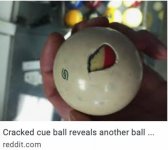I think this is an interesting discussion topic. It's probably not something that would ever be implemented, but makes for an interesting idea.
Assuming that you could get a sphere with the exact same surface composition, texture, "hardness", and the like, I think that the size of that hollow core (or worded another way, the thickness of the outer shell) would have an effect on the way the cue responded to both impact with other balls, and most definitely with how cut tip position on the cue would create varying cue movement after impact.
Assuming that you could remove the possibility of a trampoline effect, with the shape of the cue ball not being altered at all by any impact, then the fact that the weight of the cue is distributed circumfrentially would certianly aid in having the cue ball conserve and retain whatever spin is applied by the tip of the cue. So imagine that you shot a draw shot which generated 500rpm of backspin on the cue, the cue ball would act much more like a flywheel in that the rotational energy would not bleed off as quickly as with a solid cue ball, where the weight is distributed evenly (or more evenly than in a hollow cue ball) thoughout the cue ball.
I'm thinking that the larger the hollow area, or the thinner and more dense the shell area is on such a cue ball, the more that ball would react to any kind of english, draw, or follow, and the further it would roll in general due to the weight being farther from that center point in the cue ball.
And like any other of the slight variations that we deal with, the player that would benefit most from that is the one that adapted faster to those differences.
